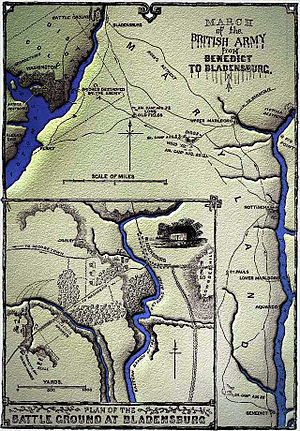Battle of Bladensberg
| Battle of Bladensburg | |||||||
|---|---|---|---|---|---|---|---|
| Part of the War of 1812 | |||||||
 Map of the campaign and battlefield of Bladensburg, with color added later, from Benson J. Lossing's Pictorial Field Book of the War of 1812 |
|||||||
|
|||||||
| Belligerents | |||||||
|
|
|
||||||
| Commanders and leaders | |||||||
|
James Madison William H. Winder Tobias Stansbury Walter Smith Joshua Barney |
Robert Ross | ||||||
| Strength | |||||||
| 6,500 militia 420 Marines and regulars 18 guns |
4,500 Marines & regulars 3 guns 60 rocket launchers |
||||||
| Casualties and losses | |||||||
| 150-197 casualties 10-26 killed 40-51 wounded 100-120 captured |
249 casualties 64 killed 185 wounded |
||||||
The Battle of Bladensburg took place during the War of 1812 on 24 August 1814. The defeat of the American forces there allowed the British to capture and burn Washington. It has been called "the greatest disgrace ever dealt to American arms".
For the first two years of the War of 1812, the British had been preoccupied with the war against Napoleon Bonaparte on the continent of Europe. However, ships of the Royal Navy, commanded by Rear Admiral George Cockburn, controlled Chesapeake Bay from early 1813 onwards and had captured large numbers of American trading vessels. Landing parties had destroyed foundries and batteries, but lack of troops restricted Cockburn to mounting small-scale raids, the largest of which was the Battle of Craney Island, which involved 2,000 men of the British Army and the Royal Marines. The British occupied Tangier Island as an anchorage and staging area. As many as 1,200 British soldiers would be stationed there. Although Cockburn withdrew from Chesapeake Bay later in 1813, his sailors had taken soundings and even placed buoys to mark channels and sandbars, in preparation for a renewed campaign in 1814.
By April 1814, Napoleon had been defeated and was exiled to the island of Elba. Large numbers of British ships and troops were now free to be used to prosecute the war with the United States. Most of these troops went to Canada where Lieutenant General Sir George Prevost, Governor General of Canada and commander in chief in North America, was preparing to lead an invasion into New York from Canada, heading for Lake Champlain. However, the Earl of Bathurst, Secretary of State for War and the Colonies, dispatched a brigade composed mainly of veterans from the Duke of Wellington's army and commanded by Major General Robert Ross, to Bermuda, from where a blockade of the American coast and even the occupation of some coastal islands had been overseen throughout the war. The intention was for this force to carry out raids on the Atlantic Seaboard to "effect a diversion on the coasts of the United States of America in favor [sic] of the army employed in the defence of Upper and Lower Canada".
...
Wikipedia
